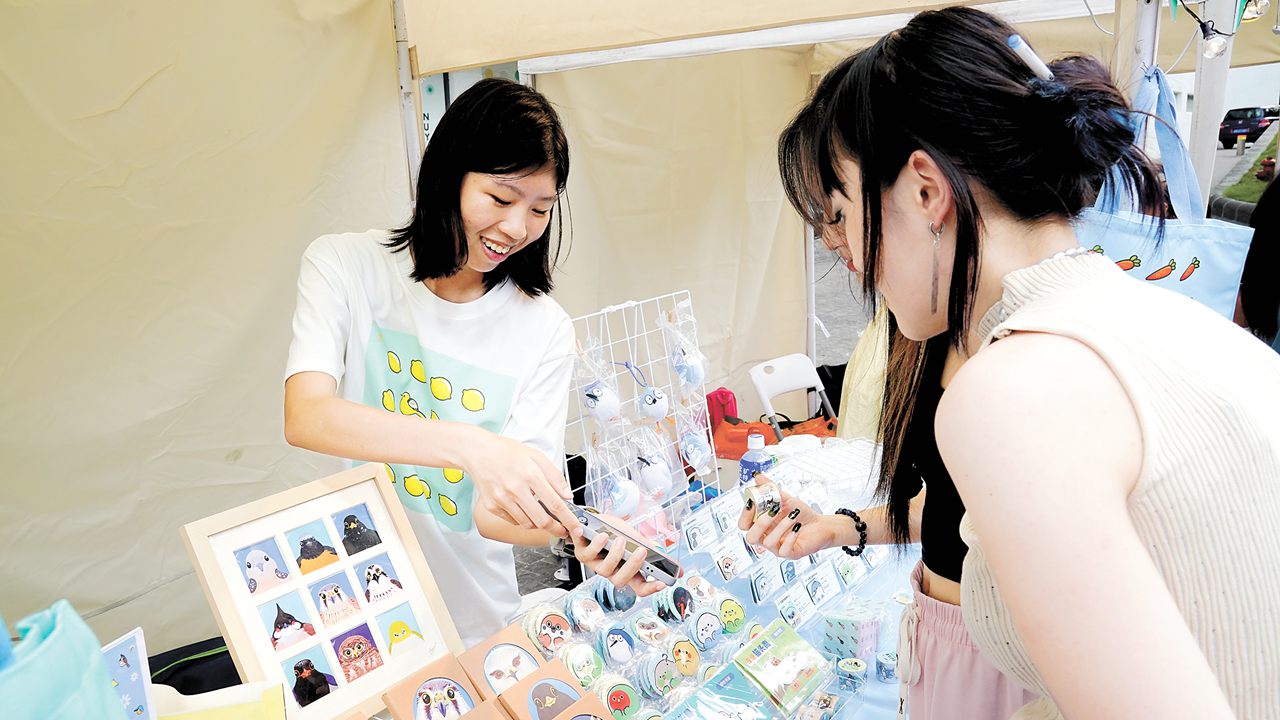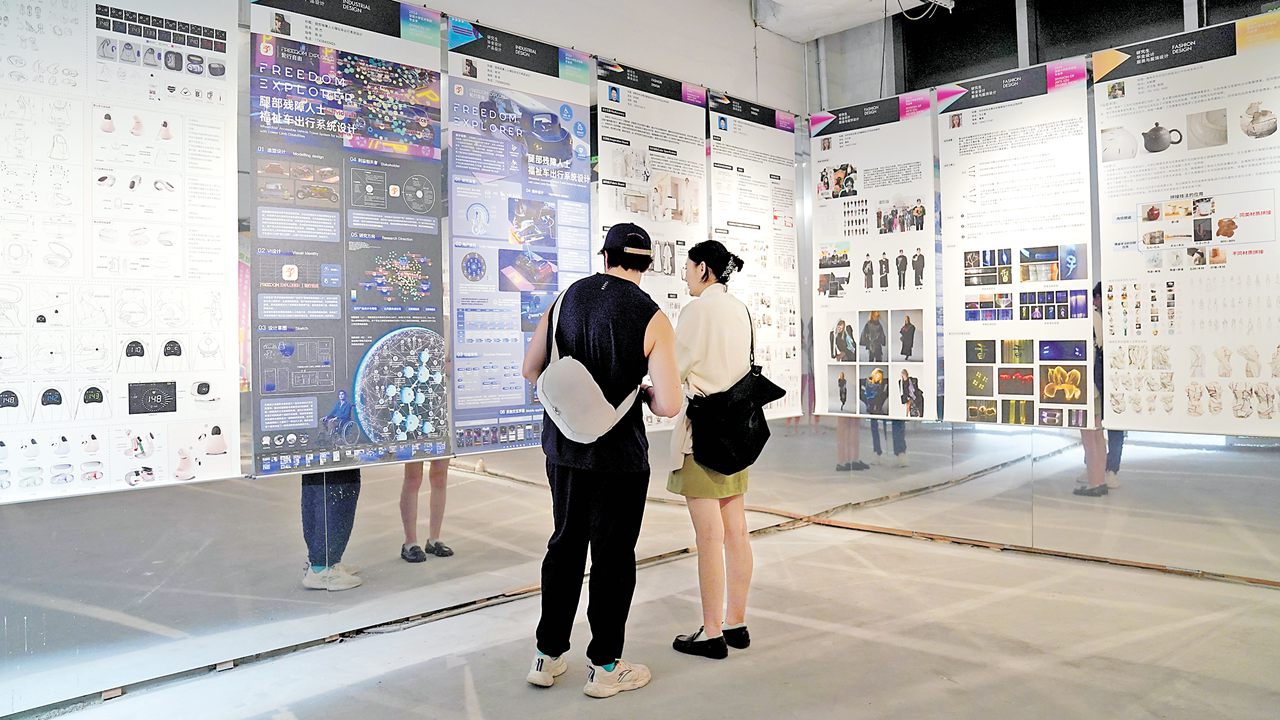Fostering rising designers in the City of Design
Writer: Wang Haolan | Editor: Zhang Zeling | From: Original | Updated: 2024-05-15

Huang Yunfei (L), a Shenzhen University (SZU) student majoring in product design, introduces her cultural creative products to visitors at a graduation project exhibition in Nantou Ancient Town on Saturday. Photos by Wang Haolan
If you can’t make it to Beijing to admire the massive wool-felt model of two sleeping leopard cats at the graduate student exhibition of the 2024 Chinese Academy of Fine Arts Graduation Season, you can still experience “A Lonely Daydream,” an equally cute and dolly artwork created by a sculpture student from the College of Art and Design at Shenzhen University’s (SZU’s) Division of Arts using the same material.
Under the theme “New Wave,” the degree show of SZU’s Division of Arts, running from mid-April to mid-May, features exhibitions of graduation projects created by undergraduate and postgraduate students from the division’s College of Art and Design, College of Music and Dance, and College of Theater at the school and Nantou Ancient Town.
An academic conference spotlighting the sustainable development of Cities of Design is also part of the 2024 Milan Fashion Week China Week.
UNESCO’s Cities of Design Network states on its official website that one of the factors contributing to Shenzhen’s designation as a City of Design is the professional capacities of designers in this city.
Leveraging cutting-edge technologies and their Gen Z worldview, the students’ works offer a glimpse into how rising designers are nurtured for the future of the City of Design.
A showcase of future design trend
The design-related projects on display at the exhibition at Nantou Ancient Town, which runs through Sunday, focus on genres such as environment design, visual communication design, product design, fashion design, digital media arts, and more.

Citizens take interest at the graduation projects created by postgraduate students from SZU’s Division of Art in Nantou Ancient Town on Saturday.
A metaverse-based cultural community in the Shenzhen Bay Super Headquarters Base, a fashion runway supported by Web 3.0 and alternate reality games (ARG) technologies, the visual identity of a traditional coming-of-age ceremony in Guangdong’s Chaoshan region, a gambiered gauze (Xiangyunsha) outfit utilizing optical fiber materials, and a smart accessible vehicle for wheelchair users are some of the innovative projects.
The students have taken full advantage of their creativity, technological capabilities, and social consciousness to create design works that not only show future industrial trends but also offer solutions to real-world challenges.
Huang Yunfei, a graduate student majoring in product design, is showcasing her graduation project — six creative seals inspired by commonly seen birds in Shenzhen. Each seal not only captures the appearance of the bird it represents, but also features a mark consistent with the footprint of that species.
“My inspiration comes from the signage system at Hong Kong Wetland Park, which uses the footprints of birds as ground direction signs,” Huang explained. “To bring this concept to life, I used a 3D printer to create white models of each stamp and then applied coatings to them, using photos of each bird as my reference. I also bought an illustrated handbook from Japan to ensure accuracy.”
Huang said if her design were to enter mass production someday, she would like to transform it into a blind box toy. Children could use the stamps to decorate their journals or learn about the unique characteristics of birds in Shenzhen.
Fostering designers
Established in 2019, SZU’s Division of Arts has enrolled more than 3,000 undergraduate and postgraduate students. For the opening ceremony of the division degree show April 29, Huang was invited to deliver a speech.
“During my four years at SZU, my focus has predominantly been on birds and birdwatching, whereas other classmates may have explored various projects,” Huang said. “However, my teachers have been supportive. They not only encouraged me to integrate my personal interest in nature education into my academic projects, but also motivated me to participate in design competitions and showcase my work.”
Huang is planning to exhibit some of her bird-related cultural creative products at the upcoming 20th China (Shenzhen) International Cultural Industrial Fair.
From classroom to showroom
At a market — a sideline event of the degree show, Huang and one of her schoolmates hosted a booth selling cultural creative products from her brand “Feather.” The products included stickers, masking tapes, badges, magnets, bag charms, Rubik’s cubes, and mug mats, all featuring images of different bird species designed by Huang.
Huang’s products are now available in the souvenir shops of the Guan Shanyue Art Museum, the Nanshan Museum, and the Bug Hug animal experience store in Nantou Ancient Town.
According to Yu Xiaobao, an assistant professor at the College of Art and Design of SZU’s Art Division, many graduate students have received offers from renowned companies or have embarked on entrepreneurship ventures like Huang as a positive consequence of the division’s entrepreneurial education.
“Before graduation, we had already helped our students get connected with cooperative parties such as OCT and Nantou Ancient Town,” Yu said. “We have also taught them business management and marketing skills to facilitate the process of commercializing their creativity and integrating into the local design supply chain.”